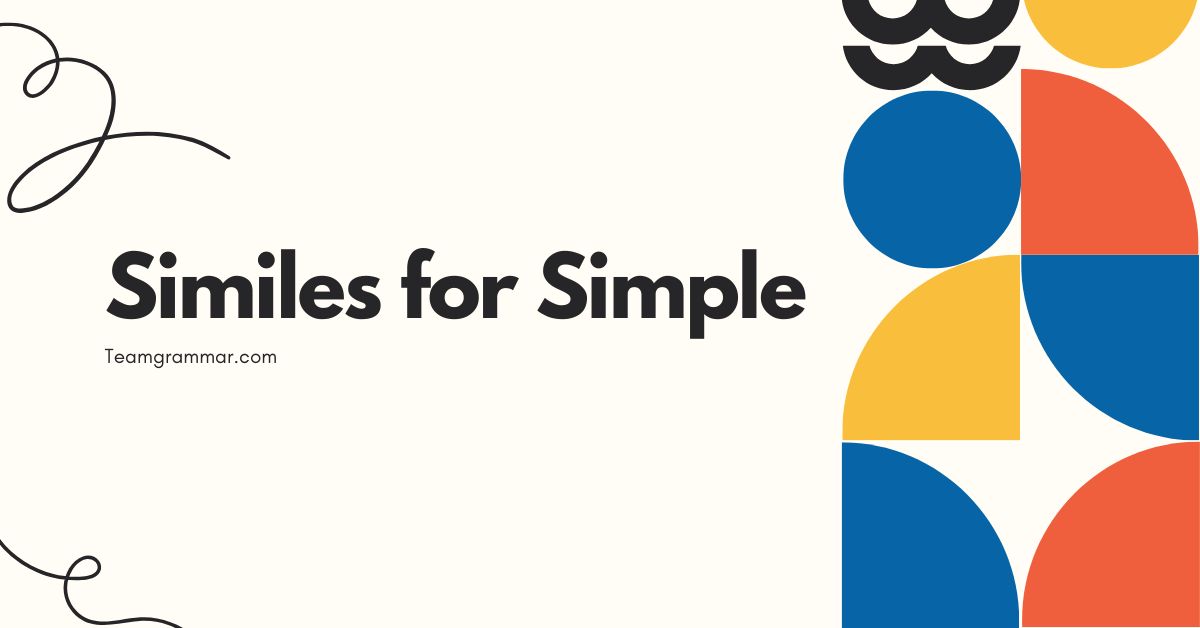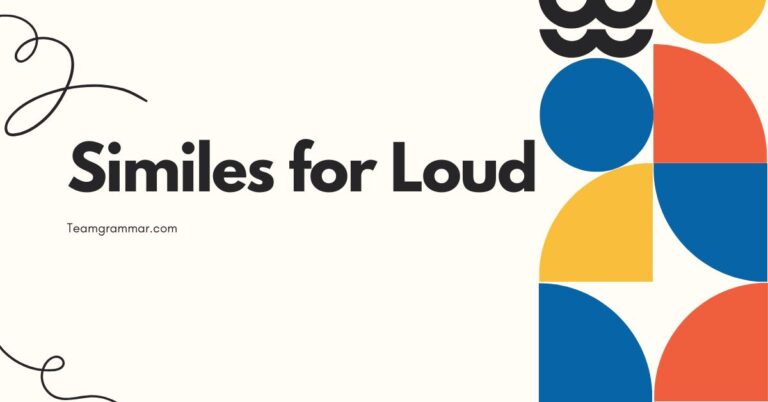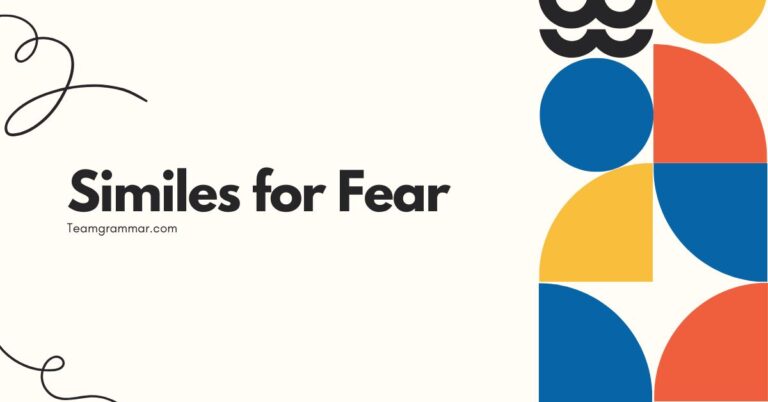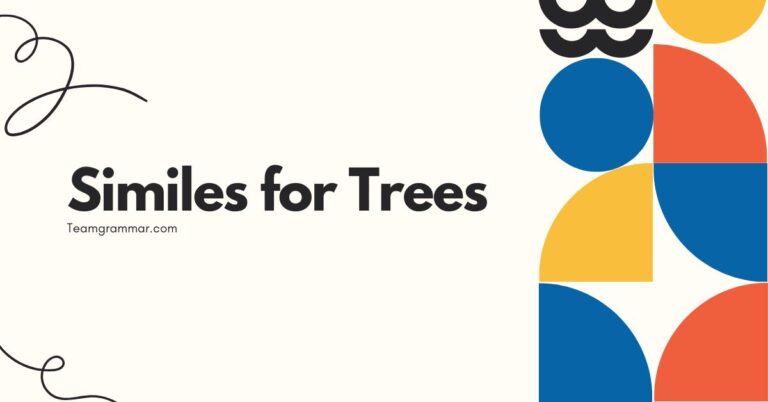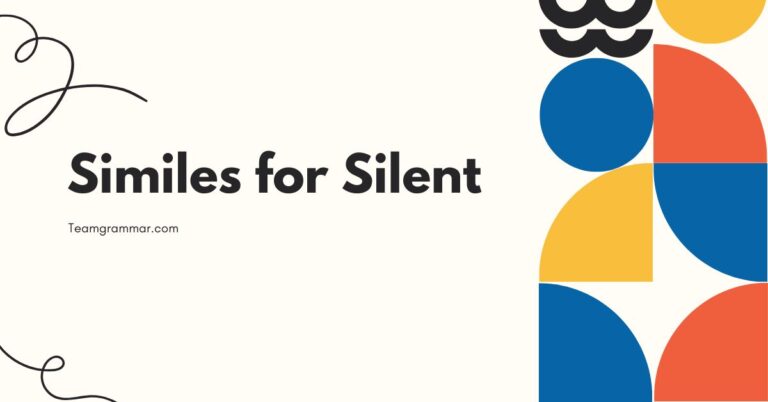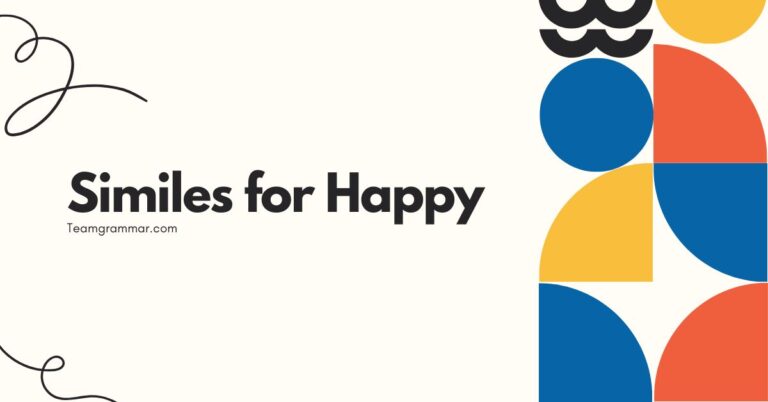37 Similes for Simple: Mastering Figurative Language
Understanding similes is crucial for enhancing your writing and comprehension skills in English. Similes, a type of figurative language, allow you to create vivid comparisons and make complex ideas more accessible.
This article provides a comprehensive guide to similes, focusing on their structure, usage, and impact. Whether you’re a student, writer, or language enthusiast, this guide will equip you with the knowledge and tools to effectively use similes in your communication.
Table of Contents
- Introduction
- Definition of a Simile
- Structural Breakdown of Similes
- Types of Similes
- Examples of Similes
- Usage Rules for Similes
- Common Mistakes When Using Similes
- Practice Exercises
- Advanced Topics in Similes
- Frequently Asked Questions (FAQ)
- Conclusion
Definition of a Simile
A simile is a figure of speech that compares two unlike things using the words “like” or “as.” Its primary function is to provide a clearer or more vivid description by drawing a parallel between something familiar and something less known. Similes are commonly used in literature, poetry, and everyday conversation to enhance understanding and create imagery.
The key characteristic of a simile is its explicit comparison. Unlike metaphors, which imply a resemblance by stating that one thing *is* another, similes use “like” or “as” to make the comparison direct and obvious.
This directness makes similes a powerful tool for conveying specific qualities or characteristics.
Similes can serve various purposes depending on the context. They can simplify complex ideas, add emotional depth, or inject humor into a situation.
The effectiveness of a simile lies in its ability to create a memorable and relatable image in the reader’s or listener’s mind. A well-crafted simile can transform an ordinary sentence into a striking and impactful statement.
Structural Breakdown of Similes
The basic structure of a simile consists of three main components: the subject, the linking word (like or as), and the object of comparison. Understanding each component is essential for constructing effective and meaningful similes.
Subject:This is the thing being described or compared. It is the focal point of the simile and the element that the writer or speaker wants to illuminate.
The subject can be a person, place, thing, or abstract concept.
Linking Word: The words “like” or “as” serve as the bridge between the subject and the object of comparison. These words explicitly indicate that a comparison is being made, distinguishing similes from other types of figurative language like metaphors.
Object of Comparison:This is the thing to which the subject is being compared. It should have a quality or characteristic that is similar to the subject, thereby enhancing the description.
The object of comparison should be familiar or easily understood by the audience.
For example, in the simile “The night was as dark as ink,” “the night” is the subject, “as” is the linking word, and “ink” is the object of comparison. The simile suggests that the darkness of the night is comparable to the darkness of ink, creating a vivid image in the reader’s mind.
Types of Similes
Similes can be categorized based on the nature of the comparison they make. Two common types are positive similes and negative similes.
Each type serves a distinct purpose and adds a unique flavor to the writing.
Positive Similes
Positive similes highlight the similarities between two things. They are used to emphasize the shared qualities or characteristics of the subject and the object of comparison.
These similes often create a favorable or affirmative impression.
For instance, “He isas brave as a lion” is a positive simile. It emphasizes the subject’s bravery by comparing him to a lion, which is widely recognized as a symbol of courage.
This type of simile is effective for praising or admiring someone or something.
Negative Similes
Negative similes, on the other hand, emphasize the lack of similarity or highlight differences. They are used to describe what something is *not* like.
These similes can be useful for creating contrast or conveying a sense of inadequacy.
An example of a negative simile is “She is not as bright as a button.” This simile suggests that the person being described is not particularly intelligent or clever. Negative similes can be used to criticize or express disappointment.
Examples of Similes
Similes can be used in various contexts to achieve different effects. Here are several examples categorized by their primary function:
Similes for Clarity
These similes are used to simplify complex ideas or make them more understandable by comparing them to something familiar.
The following table provides examples of similes used for clarity. Each example uses “like” or “as” to draw a direct comparison, making the concept easier to grasp.
| Simile | Explanation |
|---|---|
| Explaining quantum physics is like trying to catch smoke with your bare hands. | This simile conveys the difficulty and elusiveness of understanding quantum physics. |
| The instructions were as clear as mud. | This simile indicates that the instructions were confusing and difficult to understand. |
| His explanation was like watching paint dry. | This simile suggests that the explanation was boring and tedious. |
| The concept of blockchain is like a digital ledger. | This simile simplifies the concept of blockchain by comparing it to a familiar ledger. |
| Understanding the algorithm is like deciphering a secret code. | This simile illustrates the complexity and difficulty of understanding the algorithm. |
| Her directions were as helpful as a screen door on a submarine. | This simile emphasizes the uselessness of her directions by comparing them to something clearly unhelpful. |
| The process was as simple as pie. | This simile indicates that the process was very easy and straightforward. |
| Navigating the bureaucracy was like wading through treacle. | This simile conveys the slowness and difficulty of navigating the bureaucracy. |
| The problem was as plain as the nose on your face. | This simile suggests that the problem was very obvious and easy to see. |
| Her speech was like a soothing balm. | This simile indicates that her speech was comforting and calming. |
| The politician’s promises were as empty as a politician’s heart. | This simile suggests that the promises were insincere and meaningless. |
| The new software was like a breath of fresh air. | This simile indicates that the software was refreshing and innovative. |
| His excuse was as flimsy as a house of cards. | This simile conveys the weakness and instability of his excuse. |
| The company’s policies were like a maze. | This simile illustrates the complexity and confusion of the company’s policies. |
| The task was as easy as ABC. | This simile indicates that the task was very simple and straightforward. |
| The explanation was like trying to explain color to a blind person. | This simile conveys the difficulty and futility of explaining something to someone who cannot understand it. |
| The project’s timeline was as flexible as a steel bar. | This simile emphasizes the inflexibility of the project’s timeline. |
| The situation was like walking on eggshells. | This simile suggests that the situation was delicate and required careful handling. |
| The silence was as loud as a fire alarm. | This simile indicates that the silence was noticeable and filled with tension. |
| The data was like gold dust. | This simile suggests that the data was valuable and precious. |
| The website’s interface was as intuitive as using a hammer to type. | This simile conveys the non-intuitive and difficult nature of the website’s interface. |
| The instructions were as helpful as giving someone directions on a map with no roads. | This simile emphasizes the uselessness of the instructions. |
| The code was like a tangled web. | This simile illustrates the complexity and confusion of the code. |
Similes for Emphasis
These similes are used to intensify a description or highlight a particular quality. They make the description more vivid and memorable.
The following table provides examples of similes used for emphasis. These similes strengthen the description by drawing a comparison to something widely recognized or impactful.
| Simile | Explanation |
|---|---|
| His anger was like a raging fire. | This simile emphasizes the intensity and destructiveness of his anger. |
| She ran as fast as the wind. | This simile highlights her incredible speed. |
| The pain was like a knife twisting in his gut. | This simile intensifies the feeling of pain. |
| His determination was like a rock. | This simile emphasizes his unwavering resolve. |
| Her voice was as smooth as silk. | This simile highlights the pleasant and refined quality of her voice. |
| The city was as busy as a beehive. | This simile emphasizes the bustling and active nature of the city. |
| His love for her was like a deep ocean. | This simile conveys the depth and vastness of his love. |
| The challenge was as daunting as climbing Mount Everest. | This simile emphasizes the difficulty and scale of the challenge. |
| Her beauty was like a radiant sunrise. | This simile highlights her captivating and stunning beauty. |
| His words were as sharp as a razor. | This simile emphasizes the cutting and incisive nature of his words. |
| The traffic was as slow as molasses in January. | This simile emphasizes the extreme slowness of the traffic. |
| His laughter was like music to her ears. | This simile highlights how pleasing and enjoyable his laughter was to her. |
| The pressure was like a vise tightening around his head. | This simile intensifies the feeling of pressure and stress. |
| Her eyes were as bright as stars. | This simile emphasizes the sparkling and radiant quality of her eyes. |
| His memory was like an elephant’s. | This simile highlights his exceptional memory. |
| The storm was as fierce as a cornered tiger. | This simile emphasizes the intensity and ferocity of the storm. |
| Her smile was like sunshine on a cloudy day. | This simile conveys the warmth and happiness her smile brought. |
| His resolve was as unbreakable as a diamond. | This simile emphasizes his unwavering determination. |
| The silence was as thick as pea soup. | This simile emphasizes the heavy and oppressive nature of the silence. |
| Her touch was as gentle as a feather. | This simile highlights the delicate and tender quality of her touch. |
| The company’s growth was as rapid as a wildfire. | This simile emphasizes the speed and extent of the company’s growth. |
| His focus was like a laser beam. | This simile highlights his intense concentration. |
| The tension in the room was as palpable as a physical barrier. | This simile emphasizes the strong and noticeable tension in the room. |
Similes for Humor
These similes are used to create a humorous effect by comparing something in an unexpected or absurd way.
The following table provides examples of similes used for humor. These similes introduce an element of absurdity or unexpected comparison to create a funny effect.
| Simile | Explanation |
|---|---|
| He was as funny as a screen door on a submarine. | This simile suggests that he was not funny at all. |
| Trying to argue with him is like wrestling a pig in mud. | This simile conveys the futility and messiness of arguing with him. |
| Her singing voice was like a cat being strangled. | This simile suggests that her singing voice was unpleasant. |
| His jokes were as dry as the Sahara Desert. | This simile indicates that his jokes were not funny. |
| He was as useful as a chocolate teapot. | This simile suggests that he was completely useless. |
| The meeting was as productive as rearranging deck chairs on the Titanic. | This simile emphasizes the lack of real progress or value in the meeting. |
| His dancing was like a newborn giraffe trying to walk. | This simile creates a humorous image of awkward and clumsy dancing. |
| She was as graceful as a bull in a china shop. | This simile suggests that she was clumsy and prone to causing accidents. |
| His fashion sense was like a clown designed it. | This simile indicates that his fashion sense was ridiculous. |
| He was about as romantic as a tax audit. | This simile suggests that he was not romantic at all. |
| His cooking skills were like a toddler let loose in a kitchen. | This simile conveys the messiness and lack of skill in his cooking. |
| The presentation was as exciting as watching grass grow. | This simile suggests that the presentation was incredibly boring. |
| His attempts at flirting were like a rusty robot trying to be charming. | This simile creates a humorous image of awkward and unsuccessful flirting. |
| The task was as enjoyable as a root canal. | This simile indicates that the task was unpleasant and painful. |
| His sense of direction was like a broken compass. | This simile suggests that he had no sense of direction. |
| The project was as organized as a squirrel’s stash of nuts. | This simile emphasizes the disorganization and chaos of the project. |
| His listening skills were like a selective hearing aid. | This simile suggests that he only listened to what he wanted to hear. |
| The software was as user-friendly as an alien spaceship. | This simile indicates that the software was difficult to use. |
| His apologies were as sincere as a politician’s promise. | This simile suggests that his apologies were insincere. |
| The meeting was as useful as a paper umbrella in a hurricane. | This simile emphasizes the uselessness of the meeting. |
Similes for Imagery
These similes are used to create vivid and descriptive images in the reader’s mind, enhancing the sensory experience.
The following table provides examples of similes used to create vivid imagery. These similes appeal to the senses, making the description more engaging and memorable.
| Simile | Explanation |
|---|---|
| The forest was as dark as a dungeon. | This simile creates a sense of foreboding and mystery. |
| The stars were like diamonds scattered across the sky. | This simile creates a beautiful and glittering image. |
| The rain fell like tears from the heavens. | This simile evokes a sense of sadness and cleansing. |
| The sunset was like a painting of fire and gold. | This simile creates a vibrant and stunning visual. |
| The snow was as white as a dove’s feather. | This simile creates an image of purity and softness. |
| The wind howled like a banshee in the night. | This simile creates an eerie and haunting image. |
| The waves crashed like thunder against the shore. | This simile creates a powerful and dramatic auditory image. |
| The desert was as barren as the surface of the moon. | This simile creates a sense of desolation and emptiness. |
| The flowers were like jewels scattered in a green field. | This simile creates a colorful and precious image. |
| The fog hung like a shroud over the city. | This simile creates a sense of mystery and gloom. |
| The river flowed like liquid silver in the moonlight. | This simile creates a shimmering and ethereal image. |
| The trees stood like silent sentinels guarding the forest. | This simile creates a sense of watchfulness and protection. |
| The clouds were like cotton candy floating in the sky. | This simile creates a whimsical and lighthearted image. |
| The fire crackled like a hungry beast devouring wood. | This simile creates a vivid and intense auditory and visual image. |
| The autumn leaves fell like confetti from the sky. | This simile creates a festive and colorful image. |
| The mountains rose like giants guarding the horizon. | This simile creates a sense of grandeur and power. |
| The ocean was as blue as a sapphire. | This simile creates a rich and vibrant visual. |
| The meadow was like a green carpet stretching to the hills. | This simile creates a peaceful and expansive image. |
| The city lights twinkled like a million fireflies. | This simile creates a magical and enchanting visual. |
| The waterfall cascaded like a ribbon of white silk. | This simile creates a graceful and elegant image. |
Similes for Simplicity
These similes are used to explain something in simple terms that are easy to understand and relate to, making complex topics more accessible.
The following table provides examples of similes used to simplify complex topics. These similes create an easy-to-understand comparison to make the concept more relatable and accessible.
| Simile | Explanation |
|---|---|
| The human brain is like a supercomputer. | This simile simplifies the complexity of the brain by comparing it to a well-known advanced technology. |
| A cell in the body is like a tiny factory. | This simile explains the function of a cell in simple terms. |
| The internet is like a global library. | This simile makes the vastness and accessibility of the internet easier to understand. |
| Learning a new language is like climbing a mountain. | This simile explains the challenge and effort involved in language learning. |
| The stock market is like a seesaw. | This simile simplifies the fluctuating nature of the stock market. |
| A healthy diet is like fuel for a car. | This simile explains the importance of diet for energy and function. |
| The heart is like a pump. | This simile simplifies the heart’s function in circulating blood. |
| Sleep is like recharging your batteries. | This simile explains the restorative function of sleep. |
| Emotions are like waves in the ocean. | This simile makes the fluctuating nature of emotions easier to understand. |
| The solar system is like a merry-go-round. | This simile explains how the planets move around the sun. |
| The immune system is like an army. | This simile simplifies how the body defends itself against infections. |
| DNA is like a blueprint for building a house. | This simile explains the function of DNA in creating life. |
| The lungs are like bellows. | This simile simplifies the lungs’ function in breathing. |
| A computer virus is like a disease. | This simile explains the harmful nature of a computer virus. |
| The scientific method is like solving a puzzle. | This simile explains the process of scientific discovery. |
Usage Rules for Similes
When using similes, it’s important to follow certain rules to ensure clarity and effectiveness. Here are some key guidelines:
- Ensure a Clear Comparison: The subject and object of comparison should have a recognizable similarity. The comparison should be easily understood by the audience.
- Avoid Clichés: Overused similes can weaken your writing. Try to create fresh and original comparisons.
- Maintain Consistency: The simile should fit the tone and style of your writing. Avoid jarring or inappropriate comparisons.
- Use Sparingly: Overusing similes can make your writing feel cluttered. Use them judiciously to enhance specific points.
- Consider Your Audience: Choose comparisons that will resonate with your target audience. Be mindful of cultural differences and sensitivities.
Common Mistakes When Using Similes
Even experienced writers can make mistakes when using similes. Here are some common errors to avoid:
| Incorrect | Correct | Explanation |
|---|---|---|
| He is like a tall building. | He is as tall as a skyscraper. | The original simile lacks specificity. |
| She sings like a bird, but not really. | She sings like a nightingale. | The added phrase negates the simile’s impact. |
| The car is as fast as a vehicle. | The car is as fast as a race car. | The object of comparison is too general. |
| He was as angry as anger. | He was as angry as a hornet. | The comparison should be concrete, not abstract. |
Practice Exercises
Test your understanding of similes with these exercises:
Exercise 1: Identifying Similes
Identify the similes in the following sentences:
| Question | Answer |
|---|---|
| 1. The snow fell like a soft blanket. | like a soft blanket |
| 2. Her eyes were bright stars. | (No simile) |
| 3. He was as brave as a lion. | as brave as a lion |
| 4. The road was long and winding. | (No simile) |
| 5. The water was as clear as glass. | as clear as glass |
| 6. The clouds looked like fluffy cotton candy. | like fluffy cotton candy |
| 7. The music sounded like a gentle breeze. | like a gentle breeze |
| 8. She moved as swiftly as a deer. | as swiftly as a deer |
| 9. The cake tasted delicious. | (No simile) |
| 10. His words were as sharp as knives. | as sharp as knives |
Exercise 2: Completing Similes
Complete the following similes with an appropriate ending:
| Question | Answer |
|---|---|
| 1. He was as quiet as a __________. | mouse |
| 2. She was as busy as a __________. | bee |
| 3. The coffee was as hot as __________. | lava |
| 4. The test was as easy as __________. | pie |
| 5. The room was as dark as __________. | night |
| 6. They fought like __________ and __________. | cats, dogs |
| 7. The baby slept like a __________. | log |
| 8. The joke was as dry as __________. | dust |
| 9. The explanation was as clear as __________. | crystal |
| 10. The wind howled like a __________. | wolf |
Exercise 3: Creating Similes
Create your own similes to describe the following:
| Description | Example Simile |
|---|---|
| A crowded room | The room was like a can of sardines. |
| A difficult task | The task was as hard as nails. |
| A beautiful song | The song was like a sweet melody. |
| A cold day | The day was as cold as ice. |
| A fast car | The car was as quick as lightning. |
| A peaceful forest | The forest was like a serene sanctuary. |
| A grumpy person | He was as grumpy as a bear. |
| A bright idea | The idea was like a light bulb turning on. |
| A stubborn mule | He was as stubborn as a mule. |
| A clear sky | The sky was as blue as sapphire. |
Advanced Topics in Similes
For advanced learners, exploring the nuances of similes can lead to more sophisticated writing. Consider these advanced topics:
- Extended Similes: These are longer similes that develop a comparison over several sentences or paragraphs.
- Implied Similes: These are similes where the linking word (“like” or “as”) is omitted, creating a more subtle comparison.
- Similes in Different Genres: Explore how similes are used differently in poetry, prose, and drama.
- Cultural Variations in Similes: Investigate how different cultures use similes to reflect their unique values and perspectives.
Frequently Asked Questions (FAQ)
- What is the difference between a simile and a metaphor?
A simile is a direct comparison using “like” or “as,” while a metaphor implies a comparison by stating that one thing *is* another. Similes are explicit, while metaphors are implicit.
- Can a simile be a cliché?
Yes, overused similes can become clichés. It’s important to strive for fresh and original comparisons to avoid dulling your writing.
- How can I make my similes more effective?
Choose objects of comparison that are vivid, specific, and relevant to your subject. Avoid vague or generic comparisons.
- Is it okay to use similes in formal writing?
Yes, similes can be used in formal writing, but they should be used sparingly and with careful consideration of tone and style.
- What is the purpose of using similes?
Similes are used to clarify, emphasize, create imagery, and add emotional depth to writing. They can make complex ideas more accessible and engage the reader’s senses.
- How do I avoid making my similes sound forced or unnatural?
Ensure that the comparison feels logical and relevant to the context. The simile should enhance the description without drawing unnecessary attention to itself.
- Can I use similes in spoken language?
Absolutely. Similes are commonly used in everyday conversation to make descriptions more vivid and engaging.
- What are some common examples of clichéd similes?
Examples include “as busy as a bee,” “as blind as a bat,” and “as strong as an ox.” Try to think of more original alternatives.
- How do I choose the right linking word, “like” or “as”?
“Like” is used to compare nouns or pronouns, while “as” is used to compare clauses or phrases. For example, “He runs like a cheetah” (nouns) vs. “He runs as fast as a cheetah” (phrases).
- What role do similes play in poetry?
In poetry, similes are often used to create vivid imagery, evoke emotions, and convey deeper meanings. They can add layers of complexity and beauty to a poem.
Conclusion
Similes are powerful tools that can significantly enhance your writing and communication skills. By understanding their structure, types, and usage rules, you can effectively employ similes to clarify complex ideas, emphasize key points, inject humor, and create vivid imagery.
Practice using similes in your writing and speaking to master this versatile figure of speech. With consistent effort, you’ll be able to craft compelling and engaging content that resonates with your audience.

